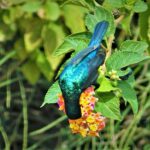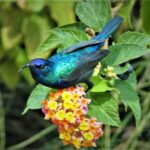Flowers and Pollinators
In Israel, almost 8 million people live in an area of about 21 square kilometres. Nowadays, urban expansion and the modern way of living influence the natural habitats because of the pollution that endangers many vegetal species, which risk extinction.
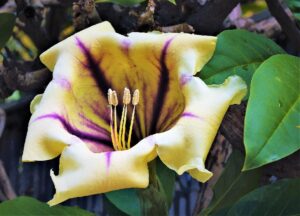
Israel has hundreds of species of wildflowers. Flowers contain the reproductive organs of their plant. After pollination and fertilization, flowers become fruits whose seeds will eventually germinate into the next generation of plants. Flowers use different natural ways to disperse their pollen, such as wind, water, insects, birds and animals.
Flowers attire their pollinators to “promote” a visit, and they accustomed to pollinators like birds, bees, beetles, and some insects. The flower typology that attires pollinating insects is featured by stripes, dots, and dark centres to attract insects in the pollen area, besides their colours, smells and shapes.
In addition, some flowers use ultraviolet light to attire bees that are sensitive to ultraviolet light. Some flowers, such as the Vartan’s Iris, have unique “landing petals” to facilitate the insects’ stability on their corollas.
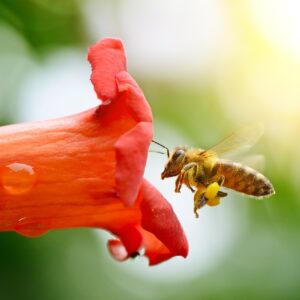
The different shapes of Israel flowers are suitable for insects’ typologies; an example is tubular flowers like the Micromeria ideal for butterflies, bees, and insects with proboscis or long tongues to reach the nectar product in the flower tube.
The flowers that rely on bird pollination are usually unscented because of the insensitivity of the birds to smells. Birds have a propensity for red, so typical bird-pollinated flowers are red flowers such as Aloe, Parasitic Mistletoe, Plicosepalus Acacia. Birds help to disperse the pollen of those red flowers and the seeds of plants with red fruits such as cherries, hawthorn, pomegranate.
Opposite to birds, most insects cannot see the red colour, except the beetles, which usually pollinate wildflowers such as the Crown Anemone, the Poppy, the Small Pheasant’s Eye and the Turban Buttercup; all of them have a similar shape, red colour and black centre. These flowers are like an open bowl, and it allows beetles to land on the flower petals and reach easily the centre where the pollen is situated. Beetles transfer the pollen covering their bodies, jumping from a flower to another one.
Israel Red Wildflowers
Israel red wildflowers bloom in different periods:
- The Crown Anemone blooms on January-February
- The Small Pheasant’s Eye and the Agen Tulips bloom on March
- The Turban Buttercup and the Poppy bloom from March to June.
The Small Pheasant’s Eye and the Poppy are annuals, while the other flowers are bulbous plants.

Israel Pale-Coloured Flowers
A rich and sweet scent features Pale-coloured and white flowers such as the Sea Daffodil, which is a favoured flower of nocturnal pollinators like the moths with a sharp smell sensitivity sometimes since at distances greater than 1km.
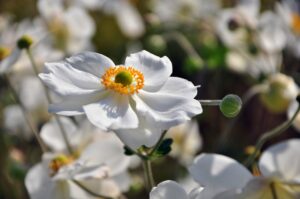
Flowers such as Arums possess a very intense smell for flies but horrible for humans. Indeed, the Israel Arum blooms comprehend a spathe and a spadix. The small flowers are in the lower part of the spadix inside the cup of the spathe. Arums usually have a purple and velvety spathe to attract pollinators like flies, which can land inside the spathe cup remaining coated with pollen. They buzz around, transferring the pollen to other flowers. In the Mediterranean area, the arums blossom in March and April.
Spring Flowers In Israel
Even though the springtime is short in Israel, from February until April, wildflowers bloom all over the country. The first flowers to blossom are the anemones and cyclamens, followed by the irises, orchids and other wildflowers.
Since spring a very fertile season, plants and flowers produce an abundance of fruits. For example, white Mustard blooms from February to April, and it is a widespread flower in Israel, covering the fields and roadsides with a yellow colour. Another typical flower of Israel is the Allium Aschersonianum, which blooms starting from March and it is one of the forty-six varieties of garlic growing spontaneously in Israel. Although these kinds of plants are typical of the Negev semi-desertic areas and Jordan Valley, they can grow in a garden since they produce beautiful ornamental flowers.
National flowers of Israel – the Crown Anemone and the Cyclamen
Maximum bloom of the Crown Anemone happens to be in January and February, covering the northern area of the Negev with a bright red. The principal pollinators of the Red Crown Anemones are the beetles and the wind. In the north area of Israel, the Crown Anemone blossoms in different colours such as dark violet, lilac and pink beside the classic bright red, attiring insects like bees and flies. The Crown Anemone and the Cyclamen are the national flowers of Israel.

Annuals Of Israel
Annuals are the most common plants in Israel, and they make up half of the endemic flora. They are herbal plants since their seasonal growth takes place quickly, not allowing them to develop any wooden element.

Among the annuals, the Blue Lupin blooms in March in the mountain slopes with its beautiful blue-violet flowers, and it is one of the most spectacular flowers of Israel. Lupins own big seeds that contain many nutrients allowing them to survive even in adverse conditions. As soon as the Blue Lupin flowers age, the flowers’ patches change colour from white to dark red, and the pollinators select the flowers with white spots.
The Egyptian Campion is an annual plant that blooms from the late winter on the mountain ridges among olive groves, with stunning pink flowers. Another annual is the Palestine Campion that blooms in March and April on the coastal plain.
Daisies make up 10% of wildflowers in Israel, blooming from winter to spring, and the most common are the Crown Daisies, the Field Marigolds, and the Spring Groundsels. Other annual plants are the Cornflower Thistle and the Iberian Centuary, which is known as dardul.
Herbaceous Perennials Of Israel
Herbaceous perennial plants are common in Israel, and they usually grow, shedding their upper parts, especially during the hot summer. Starting from the autumn with the first rains, these plants germinate rapidly.
The Bristly Hollyhock grow up to two meters, and its pollen is sticky to facilitate the dispersion through the bees’ bodies. It prospers in the Mediterranean area from April until June.
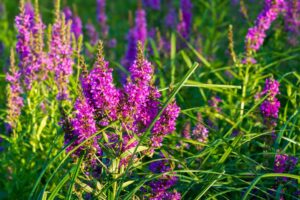
Among the herbaceous perennials, one of the most common species is the Orchis genus, distributed in tropical climates and growing as a tuberous plant in the Mediterranean regions. The orchids represent the culmination of plant speciation, and their small flowers are unusual and stunning with a complex structure.
Some orchids, such as the Anatolian Orchid, attract pollinators, although they don’t produce any nectar. Orchids like the Bee Orchids emulate nectar-bearing flowers, alluring male bee pollinators with an appearance and scent similar to the female bees. In this way, the male bees, in a fake mating process, become impregnated with pollen. In the Mediterranean regions of Israel, there are nine species of Bee Orchids.
Cultivated Flowers Of Israel
The cultivated flowers endemic of Israel and diffuse worldwide are the Hyacinth, the Cyclamen and the Narcissus. Botanists, traders and travellers exported them to other countries. Nevertheless, with time new varieties originated from the breeding of these flower species with others.
The Hyacinthus Orientalis
An example is the wild Hyacinthus Orientalis that is diffuse in the southernmost area of Galilee, where it blossoms in February and March. Unfortunately, the wild hyacinth presents fewer flowers with a very delicate scent, and their life is shorter than the cultivated ones.
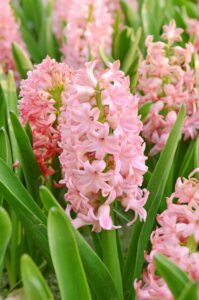
The Common Cyclamen
The Common Cyclamen is Israel national flower with the anemone. The wild species of cyclamens are cultivated worldwide, and they are the second best-selling ornamental plants after the geranium. The Common Cyclamen blooms in the eastern Mediterranean areas, and in Israel, it is the very diffuse flower in the woodlands and Mediterranean rocky hills. The beautiful Cyclamen flowers point downward, protecting the pollen from the rain and their leaves are prominent. The wild plants of Cyclamen bloom from wintertime until springtime, and they can weigh more than one kilo.
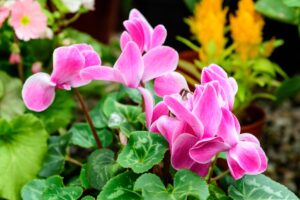
The Common Narcissus
In Israel, the Common Narcissus is a protected species growing in different environments, such as mountains and valleys, blooming in December and January. However, Narcissus can survive desert environments like the Negev Desert Highlands. Among the cultivated species, there are varieties with large flowers, and others have many petals.

Moreover, Cyclamen is a shade plant that traps the sunlight, and its dark green leaves indicate the level of chloroplasts, which are plant cell organelles conducting photosynthesis. Also, because of a red pigment on the underneaths of the new leaves, a second dose of sunlight backs to the leaf..
The Turban Buttercup
In Israel, the wild Turban Buttercup has red flowers growing in the Mediterranean and semi-desert regions; it is also endemic to the Upper Jordan Valley.
The Turban Buttercup is a delicate flower that differs from the cultivated species, which has large and impressive petals. The wild Turban Buttercup blooms in spring; the cultivated one grows from October to May.
The Wild Peony
One of the rarest plants in Israel is the Wild Peony, which grows only in the Mount Meron Nature Reserve. Indeed, because of Israel’s scorching and dry weather, this species cannot survive in the country’s other regions.
Peony usually extends from the south of Europe to the Caucasus. The Wild Peony is a rare and beautiful flower, and many people go to see these stunning flowers during their short blooming periods. The Wild Peony is one of the giant flowers in Israel, and their plants can reach one-meter highness with roots that can extend up to one-meter unto the ground.

Their extensive and reddish flowers present many yellow stamens in the centre, where the Bordeaux organs are their stigmas. Starting from February, the Wild Peony’s young stems become visible. Nevertheless, the full bloom of these plants takes place in April, and it lasts only a week.
The Peregrinating Bellflower
The Peregrinating Bellflower is an endangered flower that grows mainly in the Jerusalem Botanical Gardens after it risked extinction following a 1990s flood beside the only wild exemplars in western Galilee.
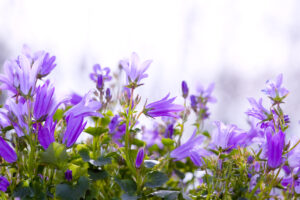
The Campanula plants were re-planted in the wild, where they keep growing thanks to a Jerusalem Botanical Gardens program. The Peregrinating Bellflowers are summer-blooming perennials, and they adorn the Jerusalem Botanical Gardens with their beautiful colour shades during the summer.
The Jerusalem Botanical Gardens
In the Jerusalem Botanical Gardens, the collection and cultivation of native plants take place, especially regarding the endangered species.
In the Gardens, there are also multi-year research projects conducted by the Hebrew University in Jerusalem to select the factors and conditions that intensify the Mediterranean plant diversification.
Indeed, it is essential to preserve the natural botanical diversity of Israel. The Jerusalem Botanical Gardens are in the heart of Jerusalem, and it is a centre of preservation of endangered botanical species, besides being a research and education centre. There is a vast collection of plants from worldwide in the Gardens, and it is a tourist pole attraction in Israel.
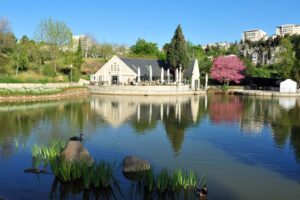
The Jerusalem Botanical Gardens extend over 122 square metres being the largest green area of Israel. Over 6000 plant species also from other countries such as Southern Africa, Europe, North America, Australia, South-West and Central Asia and the Mediterranean area. Each section of the Gardens reproduces a different environment simulating the original landscapes.
It is a sanctuary for 300 species of endangered plants that are endemic to Israel and reinserted in the wild environments, besides being preserved and displayed. Examples are the Salvia Bracteata and the Peregrinating Bellflower, whose wild versions became extinct in Israel


